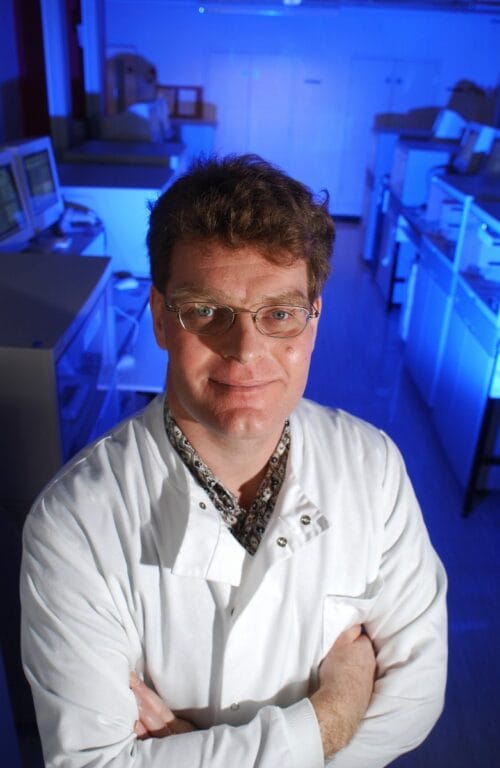Giants in genomics: Allan Bradley

Allan Bradley was director of the Wellcome Trust Sanger Institute from 2000 to 2010. His appointment as director coincided with the completion of the draft human genome sequence by the Human Genome Project.
Key terms
Embryonic Stem Cell
A stem cell derived from an early embryo. They have the ability to become any cell type.
Germline
The genetic material that can be passed onto offspring through the germ cells (e.g. sperm and egg).
Early education and career
Allan Bradley received his BA, MA and PhD in genetics from the University of Cambridge, UK. Throughout his studies, he worked in Martin Evans’ laboratory investigating mouse embryonic stem cells . This included making the important observation that embryonic stem cells could be transmitted through the germline of mice.
In the early 1980s, Allan developed a technology that made it possible to target specific genes in mice – if a gene was mutated to the extent that it no longer worked, the mouse was called a ‘knockout mouse’. This work led to Martin Evans, along with Oliver Smithies and Mario Cappecchi, winning the 2007 Nobel Prize in Physiology or Medicine.

Gene targeting technology was incredibly important for providing a key insight into the involvement of genes in cancer.
New approaches to manipulating genes in mice
In 1987, Allan moved to Houston, Texas to become an assistant professor at Baylor College of Medicine. Here, he continued working on gene targeting technology, which provided vital insight into the involvement of genes in cancer, the repair of DNA and embryonic development. His team played a central part in developing the mouse gene editing techniques and tools, which led to the publication of over 150 research papers.
Allan set high academic standards, led several committees, and was actively involved in graduate and postdoctoral training and mentoring. He was promoted to full professor in 1994, aged 34, and was also appointed as a Howard Hughes Medical Institute Investigator.
In 1995, Allan founded Lexicon Genetics Inc., and was actively engaged in commercialising the embryonic stem cell technology he had previously developed in the lab. A year later, his team developed another technology known as array-based comparative genomic hybridisation (aCGH) – which was later applied for pre- and post-natal genetic diagnosis.

When Allan was appointed director of the Sanger Institute in 2000, it was not only a time full of promise, but also a time of uncertainty for genomics.
Joining the Sanger Institute
Allan took over from John Sulston as director of the Sanger Institute in 2000 – a relatively uncertain time for genomics. The institute had been heavily involved in the Human Genome Project but at this point, the institute had been involved in the draft human genome sequence had been announced.
“The question was: how does an institute that had just one project evolve towards a more holistic approach?” says Allan. “How do you add an academic dimension to a place that has been focused on the achievement of one major technical goal for so long?”
Allan’s first task was to set out a new strategic plan for the Sanger Institute, transforming it from a centre that sequenced genomes to one focused on the biology of those sequences. He was keen to make the institute an attractive place to do innovative science, while maintaining the open philosophy and culture established by John Sulston.
Building the Sanger Institute for the future
As a starting point, Allan recruited a talented faculty of researchers, some of whom established and led large consortia projects such as the International Cancer Genome Consortium and 1000 Genomes Project. In doing so, Allan was investing in the next generation of scientists, allowing them to grow and develop into world leaders in their fields.

Allan remained director of the institute for 10 years. During this time, he oversaw the completion of the institute’s contribution to the Human Genome Project and the completion of the first mouse, malaria and cancer genome sequences.
But it wasn’t all about sequencing – Allan was also involved in many functional studies. These included the European Conditional Mouse Mutagenesis Program (EUCOMM), an international collaboration to create lines of mice in which an existing gene has been inactivated, and a major programme of malaria research.
Under his directorship, between 2005 and 2010, the Sanger Institute published more than 3,000 scientific papers with an average of one publication each week in a major scientific journal. Allan took an active role in the lab during this time, leading a group focused on developing mouse models of cancer, genetic screens in mouse embryonic stem cells and, most recently, the genetic modification of human stem cells.

Allan has been described as a “true, scientific visionary” who led the Sanger Institute into the “post-genomic era”.
Beyond the Sanger Institute
Throughout his career, Allan Bradley has played a huge role in developing animal models for use in scientific research. He has been described as a “true, scientific visionary”, who led the Sanger Institute into the “post-genomic era”.
Allan and his team moved from the Sanger Institute to the University of Cambridge in 2019, still strongly focused on using genetics to discover genes involved in various biological systems and conditions.